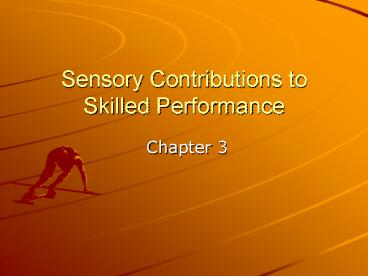Sensory Contributions to Skilled Performance - PowerPoint PPT Presentation
1 / 19
Title:
Sensory Contributions to Skilled Performance
Description:
Cutaneous receptors located in the skin; detect pressure, temperature, and contact ... effect, learned, conscious, cutaneous receptors. M3 voluntary reaction ... – PowerPoint PPT presentation
Number of Views:398
Avg rating:3.0/5.0
Title: Sensory Contributions to Skilled Performance
1
Sensory Contributions to Skilled Performance
- Chapter 3
2
Objectives
- Explain the contributions and limitations of a
closed-loop model of movement control - Understand the various ways that sensory
information is used in movement control - Discuss the various roles of vision in movement
control - Understand how sensory contributions to movements
are part of a conceptual model of motor
performance
3
Preview
- How is a rugby player able to watch the ball
leave a teammates hand with a few tenths of a
second of viewing time and realize she must turn
her back on the ball and cut sharply in one
direction to catch it? - She predicts the balls flight correctly,
visually focuses on it, times the balls arrival
into her hands, and compensates for other
external factors by grasping the ball with two
hands.
(continued)
4
Preview (continued)
- How is so much accomplished in such a short time?
- How are corrections made during skilled
performance?
5
Overview
- Processing vast amounts of information quickly
and accurately and making effective adjustments
as needed - Processes that allow performers to detect
patterns of information in the environment and
use the information to predict future actions - The neuromuscular system, the conceptual model of
motor performance, and principles of visual
control as they relate to movement
6
Exteroception
- From the environment
- Outside of the body
- Highly visual
7
Proprioception
- Information that comes from within the body,
largely from the muscles and joints
8
Interoception From Inside the Body
- KinesthesisSensory information coming from the
motor system that signals contractions and limb
movements - Vestibular apparatuslocated in inner ear
information about balance, posture, and
orientation - Muscle spindlelocated in skeletal muscle sends
information about muscle length to CNS
(continued)
9
Interoception From Inside the Body (continued)
- Golgi tendon organslocated between muscle and
tendon provide information about force in the
muscles - Cutaneous receptorslocated in the skin detect
pressure, temperature, and contact
10
Closed-Loop Control System
- Involves the use of feedback and error detection
and correction processes to maintain the desired
goal - Used to control slow and deliberate movements
(continued)
11
Closed-Loop Control System (continued)
- Good for detecting slow movement
- Not good for explaining rapid movement
- Does not account for discrete tasks
(continued)
12
Closed-Loop Control System (continued)
- Comparatorerror detection
- Executivebrain determines actions to take to
reach goal - Effectorcarries out decisions
- Feedbackprovides information on current state
13
Open-Loop Control
- Response selection and response programming
require considerable time and attention. - In the closed-loop conceptual model, corrections
occur a few hundred milliseconds after an error
occurs. - The error signal is processed in the
stimulus-identification stage.
(continued)
14
Open-Loop Control (continued)
- A movement correction is chosen in the
response-selection stage. - Modifications to the movement are organized and
initiated in the response-programming stage.
15
Compensations for Muscle Movements
- M1monosynaptic
- Most rapid, unconscious, one synapse, little
environmental impact, inflexible - M2polysynaptic
- Longer muscle, adjusts more than M1,
higher-level function, knee-jerk, sensory, cant
modify once begun
(continued)
16
Compensations for Muscle Movements (continued)
- Triggered reaction
- Wineglass effect, learned, conscious, cutaneous
receptors - M3voluntary reaction time
- Voluntary affected by instruction,
anticipation, and stimulus responses supported
by Hicks law
17
Visual Systems
- FocalIdentifies objects in center of visual
field is conscious and affected by light - AmbientDetects orientation of body in
environment is nonconscious and peripheral
18
Optical Flow
- Detects movement of patterns of light from the
environment - Perceives motion, positions, timing, stability,
velocity, and direction
19
Vision
- How does vision affect balance?
- Visual dominancevisual information dominates
information coming from the other senses - Visual capturevisual information attracts a
persons attention more easily than other forms
of information































